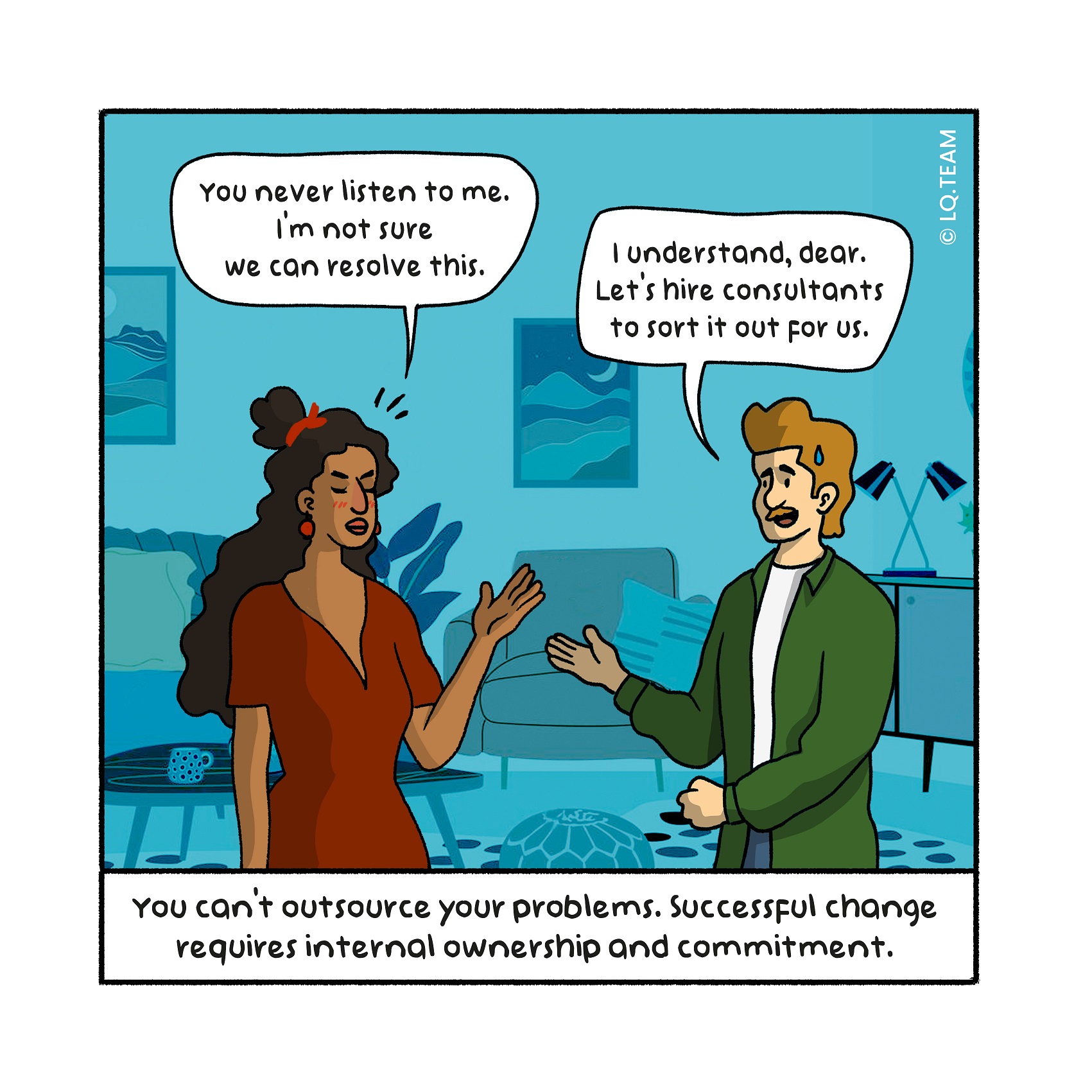
Nut to crack: How do you design a governance structure with sufficient power?
Managing organisational change initiatives requires direction. Which deci- sion-making model is necessary? Do you set up a separate programme team to steer or make the transformation part of the regular governance structure? And if you decide to create a different design, what does an effective gover- nance structure look like?
Nutcracker: No separate structure (unless…)
Managing and guiding change should be part of routine day-to-day work because it is the daily task of every leader. It is therefore preferable to avoid setting up separate roles to lead and enable the change; this typically takes away responsibility from the individuals where the accountability should sit. That does not mean that you do not need additional capacity. You may want to carry out other or different activities to drive a change process. Depending on the reason for and purpose of the change and the required pace, you can manage this as part of your everyday work, or you will have to scale up capa- city. Backfilling is often an effective method. This involves taking some of an individual’s day-to-day tasks away from them and temporarily replacing that with extra support from other colleagues or temporary workers, enabling the person in question to put in the extra effort that comes with realising change, because they can rely on spare capacity.
However, this is not always possible or feasible. When the reason for the change lies externally, for example, due to changing laws and regulations or an external threat in the market, you will sometimes have to go faster than is possible with backfilling, at least temporarily. Designing a change programme and installing a specific transformation team may be desirable then. The sup- port tool below provides help for this, and the real-life example illustrates it.
Support tool: Transformation team set-up
When setting up a transformation team, pay attention to the following three principles in designing the decision-making structure:
- Design in line with the end goal; in other words, if, for example, you want to break through the silos between the marketing and sales department, make one person responsible for improving the overall commercial result, rather than having one person for increasing marketing effectiveness and one for increasing sales effectiveness.
- Use value and impact in the workstream names, so choose, for example, a term that connects directly with the result to be generated, like “24-hour access”, rather than calling it “digital”. Make sure workstream leaders can be held to account for the business impact.
- Set up a lean & mean programme/project management office: as small as possible but fully dedicated. This provides milestones planning, design integrity, alignment and agreement between workstreams, drives deci- sion-making and tracks progress and budgets versus the value being realised.
You can depict a governance structure as visualised next. This will allow you to fill two needs with one need: you know who is responsible for the real- isation of added value, and you have clarity about the extent to which the completion of that value is on track.
Real-life example: Own team at the helm
Results are under pressure in one of the business units of an organisation known for its luxury brands. A cost reorganisation takes place. Investments in marketing have been reduced to almost zero. The management team decides to initiate a change programme to ensure that growth reinvestment can happen with its resources. They hire consultants to design and guide the programme.
After six months, the consultants have made brilliant analyses for cost savings but no ownership or belief has been developed in the organisation to realise the proposed sa vings. The director attributes this to an incorrect governance structure; consultants are in the lead, and the internal team sits at the back of the train. He intervenes. He links every consultant to an internal colleague, and places this internal colleague in the driver’s seat. He then makes the internal team responsible for the success of the programme. Consultants are given the goal of empowering their people.
Every Friday, the progress of the programme is on the agenda of the director’s man agement team for four hours. This is the meeting where all decisions are taken. Three months later, a turnaround has taken place. Not only have thousands of euros in savings been identified, but 25 colleagues have driven the realisation and reinvestment of those savings in the organisation, led by the internal change team.
Tip for change leader
If you don’t have fixed Programme or Portfolio Management Office roles in your organi sation, you could consider if they might create value for your organisation too. These are change roles that can typically ensure, if properly structured, that building the future organisation receives sufficient focus and attention compared to managing and optimi sing the presentday business.
Tip for change enabler
Rhythm is vital for sound decisionmaking. Install a weekly, fortnightly or monthly rhythm and make it crystal clear that formal decisionmaking takes place during those moments.
Kernel: Design for the change you want to see
The governance structure has excellent symbolic value; it is the most con- crete embodiment for everyone in the organisation of who and what is essen- tial in the change process. Therefore, in the design, be aware of whom you put forward as the face of the change and to whom you give decision-making authority (see also Challenge 10).
